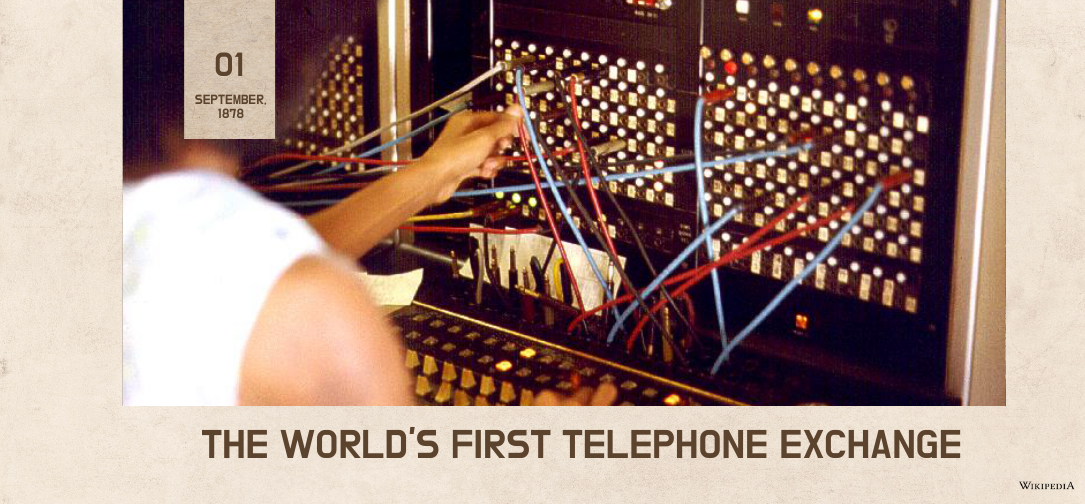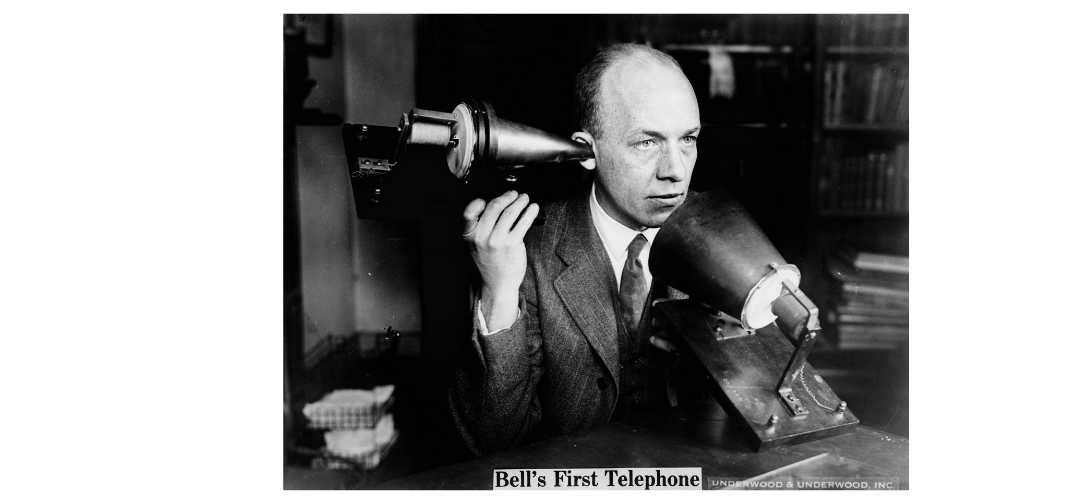Innovations
Revolution on the Wires: How the World’s First Telephone Exchange in New Haven Sparked a Global Communication Era

On September 1, 1878, a groundbreaking moment in the history of communication occurred when the world’s first commercial telephone exchange was established in New Haven, Connecticut. This innovation, brought to life by the Bell Telephone Company, marked the beginning of a new era in telecommunications, profoundly altering how people would connect with one another. The opening of the New Haven Telephone Exchange set in motion a series of developments that would lead to the creation of the vast, interconnected global communication networks we rely on today. This article delves into the historical context, technological advancements, and the lasting impact of the first telephone exchange, tracing its evolution from a revolutionary idea to a cornerstone of modern society.
The Historical Context: A World Poised for Change
The late 19th century was a period of rapid technological progress and industrial growth, particularly in the United States. The country was in the midst of the Second Industrial Revolution, a time characterized by significant advancements in manufacturing, transportation, and communication. Railroads crisscrossed the nation, the telegraph had already shrunk the perceived size of the world, and electricity was beginning to power the cities. However, despite these advancements, communication over long distances was still limited. The telegraph, though revolutionary, was constrained by the need for trained operators and the time it took to send and receive messages.
It was during this transformative period that Alexander Graham Bell, a Scottish-born inventor and scientist, introduced the world to the telephone in 1876. Bell’s invention allowed for real-time voice communication over wires, a concept that was as revolutionary as it was unimaginable at the time. While the telephone was a marvel of engineering, its initial use was limited due to the lack of infrastructure to support widespread adoption. The idea of a telephone exchange, a central hub that would allow multiple telephones to be connected to one another, was born out of this necessity.

Photo Credit: Canva
The Birth of the Telephone Exchange
The concept of the telephone exchange was rooted in the limitations of early telephone technology. Initially, telephones were connected directly to one another via a dedicated line, meaning that each pair of phones required a separate wire. This system was not only inefficient but also impractical for widespread use, as it would have required a vast network of wires crisscrossing cities and towns. The solution to this problem came in the form of a central exchange, where a single operator could manually connect calls between different telephones, eliminating the need for direct connections between each pair of users.
The idea of a telephone exchange was first proposed by Tivadar Puskás, a Hungarian engineer who had collaborated with Thomas Edison on early telephone technology. Puskás envisioned a central hub where multiple telephone lines could be connected, allowing for greater flexibility and efficiency in communication. This idea was quickly adopted by the Bell Telephone Company, which was eager to expand the reach of its new technology.
On September 1, 1878, the world’s first commercial telephone exchange opened its doors in New Haven, Connecticut. Located at 219 Chapel Street, the New Haven Telephone Exchange was a modest operation by today’s standards, but it represented a monumental leap forward in communication technology. The exchange initially served 21 subscribers, including businesses, government offices, and a few wealthy individuals, all connected through a central switchboard operated by a single person.
The Technology Behind the Exchange
The operation of the New Haven Telephone Exchange relied on relatively simple but ingenious technology. At the heart of the system was the manual switchboard, a piece of equipment that allowed the operator to connect incoming calls to the appropriate recipient. Each subscriber was assigned a unique line connected to the switchboard, and when a call was placed, the operator would physically connect the caller’s line to the recipient’s line using a patch cord. This process, while labor-intensive, allowed for multiple calls to be handled simultaneously, greatly increasing the efficiency of the telephone network.
The switchboard itself was a wooden cabinet with a series of jacks, each corresponding to a different subscriber. When a call was made, the operator would receive a signal, usually in the form of a light or a bell, indicating which subscriber was attempting to make the call. The operator would then answer the call and ask for the intended recipient. Once the recipient was identified, the operator would manually connect the two lines by inserting a patch cord into the appropriate jacks, establishing a direct connection between the caller and the recipient.
In addition to the switchboard, the New Haven Telephone Exchange also employed a system of signaling bells and lights to alert operators to incoming calls. This system was crucial in ensuring that calls were handled promptly, as the operator was responsible for managing all incoming and outgoing calls for the exchange. The technology behind the telephone exchange was relatively simple, but it laid the groundwork for the more sophisticated systems that would follow.
The People Behind the Innovation
While Alexander Graham Bell is often credited with the invention of the telephone, the success of the New Haven Telephone Exchange was the result of the combined efforts of several key individuals. In addition to Bell, who provided the initial vision and technology, others played crucial roles in bringing the exchange to life.
Tivadar Puskás, whose idea for a central exchange was instrumental in the development of the telephone network, continued to be a significant figure in the early days of telephony. His work on the telephone exchange system helped to refine and improve the technology, making it more efficient and reliable.
Thomas Watson, Bell’s assistant and collaborator, was also a key figure in the development of the telephone exchange. Watson’s expertise in engineering and his deep understanding of the telephone’s inner workings were crucial in designing and implementing the switchboard and other equipment used in the exchange.
The operators themselves, often women who were employed for their dexterity and ability to work quickly under pressure, played an essential role in the success of the exchange. These operators, who became known as “Hello Girls,” were responsible for managing all calls that passed through the exchange, ensuring that connections were made quickly and accurately. Their work was demanding, requiring both technical skill and patience, as they were often the only point of contact between callers and recipients.
The Impact of the First Telephone Exchange
The opening of the New Haven Telephone Exchange had a profound impact on communication in the late 19th century. It demonstrated the feasibility of a centralized telephone network, paving the way for the widespread adoption of the telephone. Within a few years of the exchange’s opening, similar systems were established in cities across the United States and Europe, connecting businesses, government offices, and households in a way that had never been possible before.
One of the most significant impacts of the telephone exchange was its effect on business communication. For the first time, businesses could communicate with clients, suppliers, and partners in real-time, regardless of distance. This capability revolutionized the way business was conducted, leading to increased efficiency and productivity. The ability to make instant decisions, coordinate logistics, and respond to customer inquiries transformed industries ranging from finance to manufacturing.
The telephone exchange also had a profound social impact. It brought people closer together, allowing them to maintain personal relationships over long distances. Families separated by miles could now speak to one another as if they were in the same room, reducing the sense of isolation that distance often created. This ability to stay connected, regardless of physical location, had a lasting impact on society, shaping the way people interacted and formed relationships.
Moreover, the success of the New Haven Telephone Exchange spurred further innovations in telecommunications. As demand for telephone services grew, so did the need for more sophisticated technology. The manual switchboards used in the early exchanges were soon replaced by automated systems, which could handle a larger volume of calls with greater speed and accuracy. These advancements laid the foundation for the modern telecommunications networks that connect billions of people around the world today.
Challenges and Evolution
Despite its success, the New Haven Telephone Exchange faced several challenges in its early years. One of the primary issues was the limited range of the telephone lines, which restricted the exchange’s service area. Early telephone lines were made of copper or iron wire, which were susceptible to interference and signal degradation over long distances. This limitation meant that the exchange could only connect subscribers within a relatively small geographic area.
To address this issue, engineers and inventors worked to improve the materials and design of telephone lines, eventually leading to the development of long-distance lines that could transmit signals over hundreds of miles. The introduction of these long-distance lines allowed telephone exchanges to connect with one another, creating a vast network that spanned entire regions and, eventually, the entire country.
Another challenge faced by the early telephone exchange was the labor-intensive nature of the switchboard operation. As the number of subscribers grew, so did the workload for operators, leading to increased demand for automation. The first step toward automation came in the form of the Strowger switch, an electromechanical device invented by Almon Brown Strowger in 1891. The Strowger switch allowed callers to connect directly with their intended recipient without the need for an operator, reducing the reliance on manual switchboards and paving the way for fully automated exchanges.
The evolution of the telephone exchange also led to changes in the regulatory landscape. As the telephone network expanded, it became clear that standardization and regulation were necessary to ensure consistent service and fair competition. In the United States, this led to the establishment of the Federal Communications Commission (FCC) in 1934, which was tasked with overseeing the telecommunications industry and ensuring that all Americans had access to reliable telephone service.

Legacy and Lasting Impact
The legacy of the New Haven Telephone Exchange is still evident in the modern telecommunications networks that connect people across the globe. The basic principles established by the exchange, centralized connectivity, real-time communication, and network scalability; remain fundamental to the operation of today’s communication systems.
The opening of the New Haven Telephone Exchange also set a precedent for the rapid adoption of new technology. Within a few decades of the exchange’s establishment, the telephone had evolved from a novelty to an essential tool for communication, both in business and in everyday life. This rapid adoption was driven by the recognition of the telephone’s value in facilitating connections and enhancing productivity, a realization that continues to drive technological innovation today.
Moreover, the New Haven Telephone Exchange played a crucial role in shaping the social and economic landscape of the 20th century. By making communication more accessible and efficient, the exchange contributed to the growth of industries, the expansion of cities, and the development of global trade. The ability to communicate instantly across vast distances also had a profound impact on culture, fostering a sense of global interconnectedness that has only grown stronger with time.
The New Haven Telephone Exchange’s impact on society is perhaps best summarized by considering how integral communication has become to modern life. Today, we take for granted the ability to pick up a phone and connect with someone on the other side of the world, but this capability was made possible by the innovations and advancements that began with that first telephone exchange in New Haven. The exchange not only transformed the way people communicated in the late 19th century but also laid the foundation for the interconnected world we live in today.
Conclusion
The opening of the world’s first telephone exchange in New Haven, Connecticut, on September 1, 1878, was a pivotal moment in the history of communication. This modest operation, with its simple switchboard and handful of subscribers, marked the beginning of a revolution in how people connected with one another. The success of the New Haven Telephone Exchange demonstrated the feasibility and value of a centralized communication network, paving the way for the widespread adoption of the telephone and the development of the modern telecommunications industry.
The exchange’s impact on business, society, and technology was profound, leading to increased efficiency, greater connectivity, and a more interconnected world. The challenges faced by the early telephone exchange—such as the limitations of early technology and the need for standardization—were overcome through innovation and perseverance, resulting in the sophisticated communication networks we rely on today.
As we reflect on the legacy of the New Haven Telephone Exchange, it is clear that this innovation was more than just a technological advancement; it was a catalyst for change that transformed the way people lived, worked, and interacted. The principles and practices established by the exchange continue to shape our world, reminding us of the power of communication to connect, inspire, and drive progress.
-

 Press Release4 days ago
Press Release4 days agoClinical Trials Market Set for Robust Growth, Driven by Drug Development Surge and Digital Innovation
-

 Press Release7 days ago
Press Release7 days agoBellarium ($BEL) Price Prediction: Could It Hit $5 by 2026?
-

 Press Release5 days ago
Press Release5 days agoIndustrial Boiler Market Expected to Surpass USD 24.4 Billion by 2035 Amid Growing Demand for Energy Efficiency and Industrialization
-

 Business6 days ago
Business6 days agoHow Managed IT Solutions Help Small Teams Compete at Enterprise Scale
-

 Press Release5 days ago
Press Release5 days agoPreventive Vaccines Market to Witness Strong Growth by 2035
-

 Press Release5 days ago
Press Release5 days agoGreen Bio Chemicals Market Poised for Sustainable Growth amidst Global Shift to Eco-Friendly Alternatives by 2035
-

 Press Release5 days ago
Press Release5 days agoFill-Finish Pharmaceutical Contract Manufacturing Market Expected to Flourish Amid Biopharmaceutical Boom and Global Outsourcing Trend by 2035
-

 Press Release5 days ago
Press Release5 days agoPet Food Nutraceutical Market Set for Robust Expansion Amid Rising Demand for Pet Wellness by 2035























